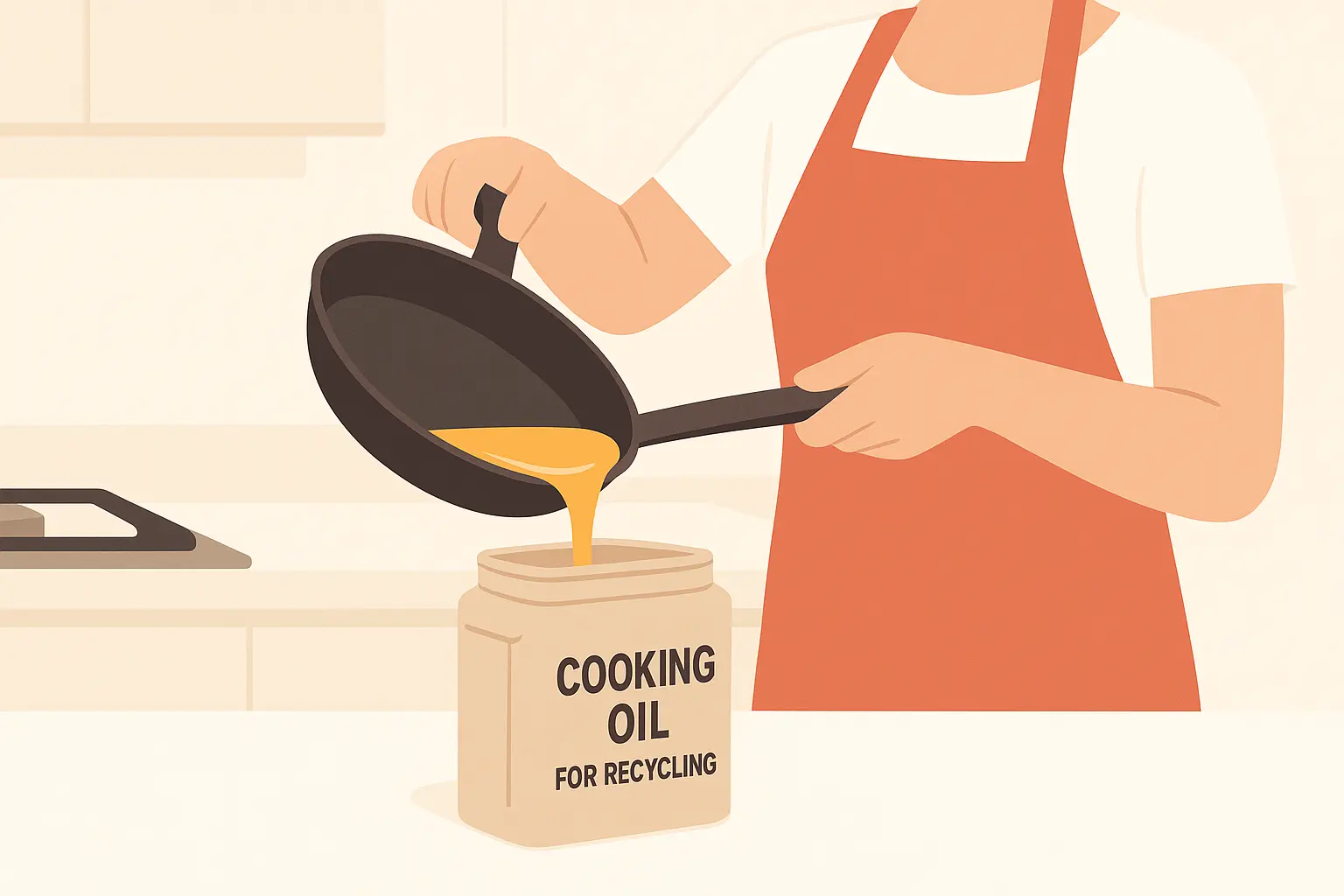Table of Contents
America’s Hidden Fuel Sitting in Our Kitchens
U.S. kitchens already funnel about 0.85 billion gallons of used cooking oil (UCO) into commercial collection each year, mostly from restaurants. Because UCO can slash sustainable aviation fuel (SAF) life cycle emissions by up to 80 percent compared with fossil jet fuel, every missed household jug matters. Analysts warn that demand for this low carbon feedstock is outpacing supply, creating price spikes and import risks. Capturing the grease now wasted down residential drains can close part of that gap while easing sewer overloads and fatberg disasters.
How Much Grease Do Homes Really Create?
Research shows the United States generated 0.6 million tons of “yellow grease”, largely household and small business leftovers. Converting that weight with the industry average 7.55 pounds of feedstock per gallon of biodiesel yields roughly 159 million gallons of potential renewable fuel, enough to fly 3,600 New York Los Angeles passenger jets on SAF blends each year. Even modest growth in curbside programs could double today’s supply long before the federal SAF Grand Challenge calls for 3 billion gallons annually by 2030.
| Data Source | Waste Grease (lbs) | Fuel Potential (gal) |
|---|---|---|
| U.S. Yellow Grease Estimate | 1.2 billion | 159 million |
Why Pipelines Start With Coffee Cans
Safe storage is simple: cool the oil, strain crumbs, and pour into a leak proof plastic or metal container. New York City advises taping the lid and labeling “Used Cooking Oil” before setting it out with trash or drop off items. A tight cap prevents odors and keeps water out, crucial because moisture spikes refining costs. Fire authorities also note that grease covered stovetops cause nearly half of home cooking fires each year, so clearing pans promptly protects more than pipelines.

From Curb to Jet Engine: The Collection Chain
Many cities now turn holiday fryer oil into fuel. Raleigh’s free curbside pick up kept hundreds of gallons out of sewers last winter, while Austin’s Recycle & Reuse Center accepts cooking oil year round. Programs like Greenville’s “Cease the Grease” even mail reusable lids to residents. Once gathered, Grease Connections transfers filtered oil to regional processing hubs that already supply biodiesel and SAF producers under Grease Connections best practices. Every gallon collected at the curb travels, within days, toward decarbonizing airport fuel hydrants.
What’s Blocking Progress and How to Fix It
The biggest barrier is convenience: most households still toss oil because bins are far away or pickup calendars are unclear. Contamination (mixing water or food scraps) can also spoil entire tanker loads, driving prices upward. Finally, clogged pipes cost U.S. cities millions; Baltimore’s 1.2 million gallon sewage overflow stemmed from a single fatberg. Solutions are proven: supply free containers, text reminders, and neighborhood drop boxes within a five minute drive. Where those tools exist, collection rates triple within one holiday season.
Economics That Make Sense for Homes and the Planet
America’s cooking oil recycling market already tops $1.6 billion and is projected to nearly double by 2032. Spot prices rose 27 percent in 2025 as SAF producers locked in feedstock. Many collection companies now credit households with coupons or charitable donations per gallon, turning a messy chore into tangible value. On the macro scale, every recycled gallon displaces about eight pounds of imported crude equivalent and trims nearly 17 pounds of CO₂. That climate dividend flows straight from frying pans to flight decks.
City Playbooks Worth Knowing About
| City | Program Highlight | Household Cost | Results |
|---|---|---|---|
| Raleigh, NC | Seasonal curbside jug pickup | Free | 5 tons oil kept out of sewers in 10 weeks |
| Miami, FL | Daily drop off at reuse center | Free | 12 k gallons recycled in 2024 |
| New York, NY | 311 disposal guide & local depots | Free | Citywide FOG backups down 15 % since 2022 |
| Atlanta, GA | Airline backed household SAF drive | Voucher per liter | Feedstock for first domestic SAF plant |
Grease Connections: Closing the Loop Together
Grease Connections already services restaurants in the East Coast and quickly expanding; now we extend the same closed loop logistics to your neighborhood. Schedule a jug drop off or explore our city partnerships to bring curbside pickup to your block. When you’re ready, see how we serve Florida, New Jersey and Georgia with 24 hour spill response and transparent rebates. Together, we’ll make sure no good grease goes to waste and every future flight leaves a lighter footprint.
[IMAGE: flat design of a Grease Connections truck collecting labeled household oil bins outside suburban homes, SAF aircraft silhouette in the sky.]









